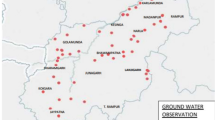Abstract
A bioremediation project has been monitored for two years at a former sour gas plant site that had ethanolamine, glycol and their degradation products in the subsurface. The active enhanced bioremediation program consisted of dewatering and bioventing. An extensive groundwater monitoring program mapped the distribution of chemical species. Principal component analysis was used to help organize and interpret the chemical analysis. Three principal components accounted for 75% of the variability in the data. The first component separated contaminated waters from background. The second component indicated aerobic versus anaerobic conditions and the third component was indicative of the accumulation of nitrogen compounds. The site is extremely heterogeneous with preferential pathways due to fractures, sand lenses and a fractured horizontal well. In addition the source and contaminated areas are very heterogeneous. The PCA shows drastically different geochemical conditions residing within relatively small areas. The study site can be conceptualized as a series of small, meter-scale sized reactors that interact and mix due to preferential flow paths and diffusion. The evolution of the chemistry shows that the bioremediation process is successfully removing acetic acid, and it is becoming more aerobic. Enhanced infiltration in the process area is slowly removing the source and degradation products.
Similar content being viewed by others
References
Bentley, L., Gharibi, M. and Lunn, S. R. D.: 2001, Time-lapse Electrical Resistivity Monitoring of Groundwater Remediation, CGS-IAH Joint Annual Meeting, Calgary, AB, Canada 17–19 September.
Butterfield, T.: 2002, Master of Science Thesis, Department of Earth Sciences, The University of Alberta, Edmonton, Canada.
Carter, M. R.: 1993, Soil Sampling and Methods of Analysis. Canadian Society of Soil Science. Lewis Publ., pp. 168–170.
Chong, S., Garelick, H., Revitt, D. M., Shutes, R. B., Worrall, P. and Brewer, D.: 1999, ‘The microbiology associated with glycol removal in constructed wetlands’, Water Science and Technology 40, 99–107.
Fedorak, P. M., Coy, D. L., Gieg, L. M., Greene, E. A., Luther, S. M. and Dudas, M. J.: 1997, ‘Assessing the fate of dipa and sulfolane in the subsurface at sour gas processing plant sites’, 6th Symposium and Exhibition on Groundwater and Soil Remediation Montreal, QC, Canada 18–21 March.
Kroschwitz, I.: 1992, Encyclopedia of Chemical Technology. 4th ed., vol. 2, pp. 1–35, Wiley Interscience, USA.
Lintott, D. R., Goudey, J. S., Wilson, J., Swanson, S. and Drury, C.: 1997, ‘The toxicity of sulfolane and DIPA from sour gas plants to aquatic species’, 6th Symposium and Exhibition on Groundwater and Soil Remediation Montreal, QC, Canada 18–21 March.
Mardia, K. V., Kent, J. T. and Bibby, J. M.: 1979, Multivariate Analysis. Academic Press, New York, pp. 213–254.
McDonald, J. A. and Portier, R. J.: 2003, ‘Feasibility studies on in-situ biological treatment of drilling muds at an abandoned site in Sicily’, J. Chem. Technol. Biotechnol. 78, 709–716.
McQueen, D., Joshi, C. J., Thongkheuang, A. and Jordan, T. L.: 1998, ‘Isolation of Glycol Degrading Bacteria’, 1998 National Conference on Environmental Remediation Science and Technology, Greensboro, NC, USA, September 1998.
McVicker, L., Duffy, D. and Stout, V.: 1997, ‘Microbial growth in a steady-state model of ethylene glycol-contaminated soil’, Current Microbiol. 36, 137–147.
Mrklas, O.: 2002, Ethanolamine and Glycol Biodegradation: From Detection to Remediation. Ph.D. Dissertation, Department of Civil Engineering, The University of Calgary, Calgary, Canada.
Mrklas, O., Chu, A. and Lunn, S. R. D.: 2003, ‘Determination of ethanolamine, ethylene glycol and triethylene glycol by ion chromatography for laboratory and field biodegradation studies’, Journal of Environmental Monitoring 5, 336–340.
Mrklas, O., Chu, A., Lunn, S. R. D. and Bentley, L. R.: 2004, ‘Biodegradation of Monoethanolamine, Ethylene Glycol and Triethylene Glycol in laboratory bioreactors’, Water, Air and Soil Pollution 159, 249–263.
Ndegwa, A., Wong, R. C., Chu, A., Bentley, L. R. and Lunn, S. R. D.: 2004, ‘Degradation of monoethanolamine in soil’, Journal of Environmental Engineering and Science 3, 137–146.
Pitter, P.: 1976, ‘Determination of biological degradability of organic substances’, Water Research 10, 231–235.
Polasek, J. C., Iglesias-Silva, G. A. and Bullin, J. A.: 1992, Using Mixed Amine Solutions for Gas Sweetening. 71rst GPA Annual Convention, Tulsa, OK, USA, 16–18 March.
Rooney, P. C., Dupart, M. S. and Bacon, T. R.: 1998, ‘Oxygen's role in alkanolamine degradation’, Hydrocarbon Processing 77, 109–113.
Scarlett, A. and Turner J. M.: 1976 ‘Microbial metabolism of amino alcohols. Ethanolamine Catabolism Mediated by Coenzyme B12-dependent Ethanolamine Ammonia-Lyase in Escherichia coli and Klebsiella aerogenes’, Journal of General Microbiology 95, 173–176.
Smart, P., Devenny, I. and Renall, A.: 1997, Hindered Amine Development and Operating Experience at Quirk Creek Gas Plant. 76th GPA Annual Convention, Tulsa, OK, USA, 10–12 March.
Sorensen, J. A., Gallagher, J. R., Chollak, D. and Harju, J. A.: 1999, ‘Remediation strategies for soils contaminated with amine-based gas sweetening wastes’, Society of Petroleum Engineers. SPE 52717.
Strong-Gunderson, J. M., Wheelis, S., Carroll, S. L., Waltz, M. D. and Palumbo, A. V.: 1995, Microbial Processes for Bioremediation. Battelle Press, Columbus, OH.
Williams, G. R. and Callely, A. G.: 1982, ‘The biodegradation of diethanolamine and triethanolamine by a yellow gram-negative rod’, Journal of General Microbiology 128, 1203–1209.
Wong, C. K. and Alfaro, M. C.: 2001, ‘Fracturing in low-permeability soils for remediation of contaminated ground’, Canadian Geotechnical Journal 38, 316–327.
Wrubleski, R. M., Drury, C. R. and Sevigny, J. H.: 1997, Chemical Contamination of Groundwater at Gas Processing Plants. 6th Symposium and Exhibition on Groundwater and Soil Remediation, Montreal, QC, Canada 18–21 March.
Author information
Authors and Affiliations
Corresponding author
Rights and permissions
About this article
Cite this article
Mrklas, O., Bentley, L.R., Lunn, S.R.D. et al. Principal Component Analyses of Groundwater Chemistry Data During Enhanced Bioremediation. Water Air Soil Pollut 169, 395–411 (2006). https://doi.org/10.1007/s11270-006-2817-5
Received:
Accepted:
Issue Date:
DOI: https://doi.org/10.1007/s11270-006-2817-5




